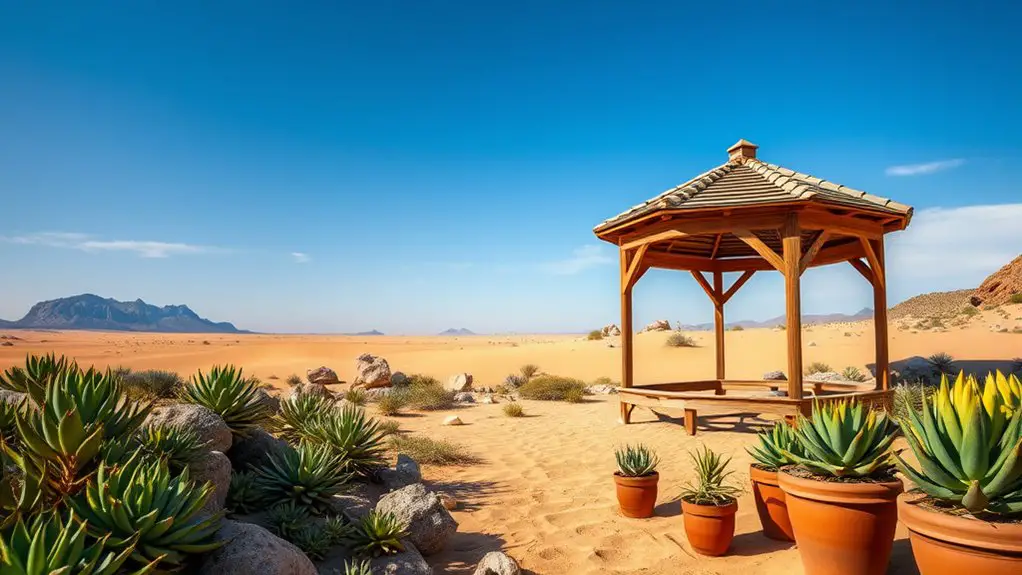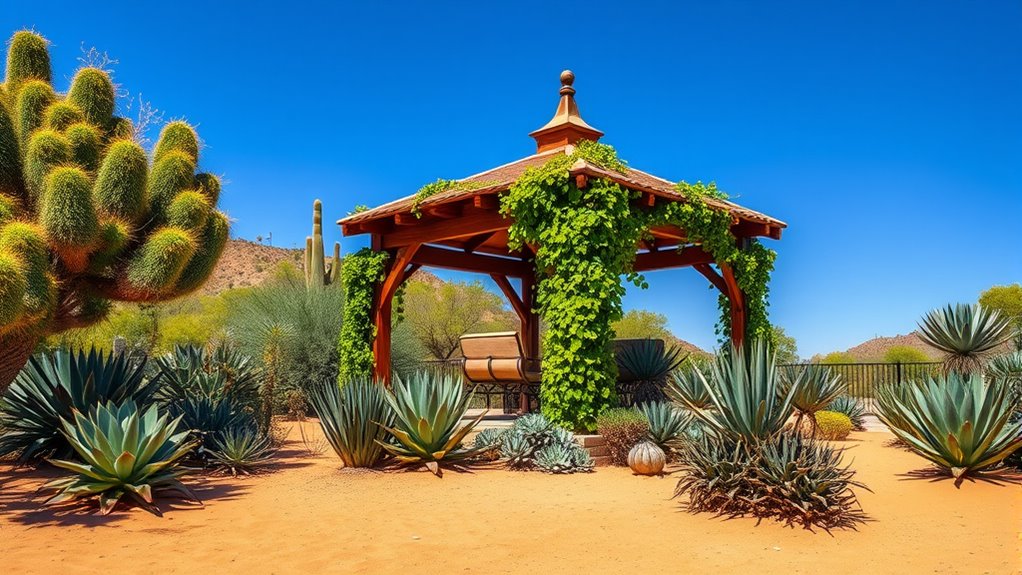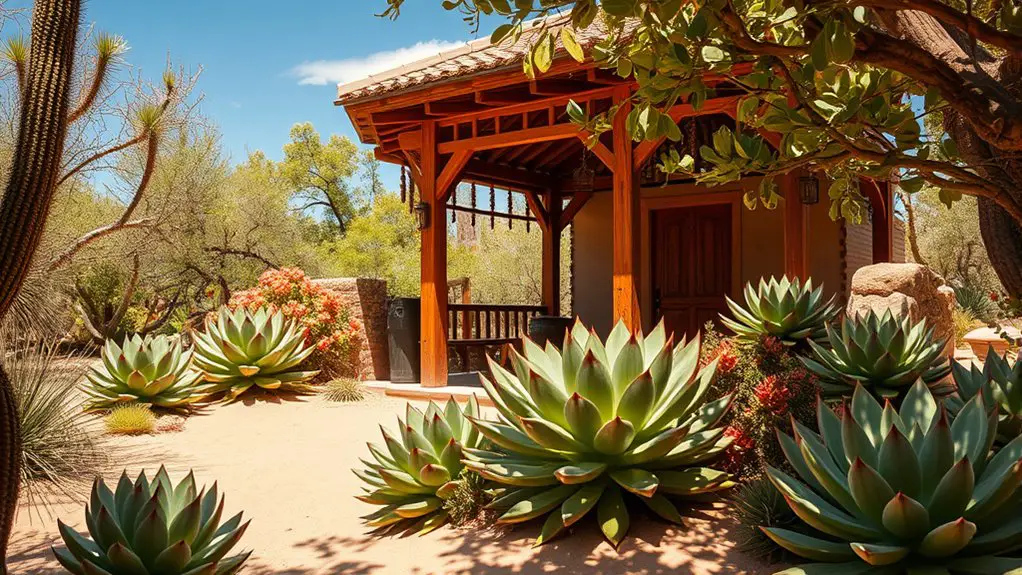To create your desert oasis gazebo with succulents, start by choosing a sunny spot that offers afternoon shade. Design a sturdy structure with a sloped roof and weather-resistant materials. Select a mix of sun-loving and shade-tolerant succulents for variety. Arrange them using colorful contrasts and different textures for visual appeal. Maintain your garden with consistent watering and natural pest control. Enhance your space with outdoor curtains and efficient lighting, ensuring a tranquil retreat that invites relaxation and connection.
Choosing the Perfect Location for Your Gazebo

When considering where to place your gazebo, have you thought about how the sun’s path will affect your succulents? Positioning your gazebo for ideal sunlight exposure is essential. Succulents thrive in bright light, but too much direct sun can scorch their leaves. Aim for a spot where morning sun gently warms them, while afternoon shade offers reprieve.
Additionally, think about wind protection. Strong gusts can damage your delicate plants, so consider placing your gazebo near natural windbreaks like trees or tall shrubs. This will create a cozy microclimate, allowing your succulents to flourish. In addition, ensure that you choose a location on flat, sturdy ground to provide stability for both your gazebo and your plants.
Take a moment to visualize how the sun moves throughout the day and how it interacts with your chosen location. By balancing sunlight exposure and wind protection, you’ll create the perfect environment for your desert oasis, where your succulents can thrive in a space that feels like your personal paradise.
Designing Your Gazebo Structure
After you’ve found the ideal location for your gazebo, it’s time to turn your attention to its design. Your gazebo should reflect your personality while ensuring structural stability. Choose the right gazebo materials to withstand the desert elements, making it a true oasis.
Design your gazebo to reflect your personality while ensuring it withstands the desert elements, creating your perfect oasis.
Here are some design elements to contemplate:
- Framework: Opt for durable materials like aluminum or treated wood for longevity.
- Roof Design: A sloped roof can shed rain and snow more effectively, protecting your oasis.
- Openings: Incorporate lattice or mesh panels for ventilation and to enhance aesthetic appeal.
- Flooring: Use weather-resistant materials like composite decking or stone for a solid base.
- Decorative Elements: Consider arches or ornamental details to add character without compromising stability. Additionally, selecting materials that are weather damage resistant will ensure your gazebo remains intact against harsh desert conditions.
Selecting the Right Succulents for Your Oasis

How do you choose the perfect succulents to complement your desert oasis? Start by exploring popular succulent varieties like Echeveria, Agave, and Haworthia, each bringing unique textures and colors. Echeveria offers rosette shapes in vibrant hues, while Agave adds dramatic architectural flair. If you’re considering indoor succulent options, look to the resilient Jade plant or the charming String of Hearts, both thriving in low-light conditions.
When selecting, think about the light and space your oasis provides. For sun-drenched corners, opt for sun-loving varieties like Sedum or Aloe Vera. Conversely, if you’re creating shaded spots, choose shade-tolerant succulents like Gasteria.
Arranging Succulents for Maximum Impact
When arranging your succulents, think about how color contrast can create visual excitement and draw the eye. By layering different heights and textures, you can add depth, making your oasis feel dynamic and inviting. Together, these techniques will transform your gazebo into a stunning focal point that captivates all who enter.
Color Contrast Techniques
Color contrast is a powerful tool in creating a visually stunning succulent arrangement that draws the eye and highlights the unique characteristics of each plant. By understanding the color wheel, you can select contrasting hues that enhance your design. Here are some techniques to elevate your succulent display:
- Pair warm and cool tones: Like fiery reds with calming blues.
- Choose complementary colors: Such as yellow and purple for a vibrant clash.
- Use monochromatic variations: Different shades of green lend depth.
- Incorporate textures: Combine smooth succulents with rough ones for added interest.
- Create focal points: Place brighter plants as highlights among muted ones.
These strategies will breathe life into your desert oasis, ensuring your arrangements are enchanting and unique.
Layering for Depth
Layering brings your succulent arrangement to life, transforming a flat display into a dynamic, three-dimensional masterpiece. To achieve this, employ layering techniques that create depth perception, drawing the eye into your oasis. Start with larger succulents at the back or center, anchoring your design. Then, place medium-sized varieties in front, allowing smaller ones to peek through the gaps. Consider varying heights and textures; the contrast adds visual interest. Use cascading plants to soften edges and create a flowing effect. Don’t forget to integrate draping succulents to spill over the edges, enhancing that layered look. With careful placement, your arrangement will not only thrive but also evoke a sense of freedom and serenity, inviting viewers to explore your enchanting oasis.
Maintaining Your Succulent Garden

To keep your succulent garden thriving, you’ll need to master the art of watering and pest control. Establishing a consistent watering schedule tailored to your climate will guarantee your plants flourish without drowning. Plus, staying vigilant against unwanted pests will protect your oasis, allowing it to shine in all its vibrant glory.
Watering Schedule Tips
Although succulents are known for their resilience, establishing an effective watering schedule is crucial to maintaining a thriving garden. Here are some tips to help you master the art of irrigation methods and seasonal adjustments:
- Check soil moisture: Always test the soil before watering; if it’s dry an inch down, it’s time.
- Water deeply but infrequently: Soak the soil thoroughly, allowing roots to absorb moisture.
- Adjust for seasons: Reduce frequency in winter and increase during hot summer months.
- Consider the environment: Sunlight and humidity can affect your watering needs.
- Use pots with drainage: Make certain excess water can escape to prevent root rot.
Pest Control Strategies
After confirming your succulents are well-watered, it’s time to turn your attention to keeping them healthy and pest-free. Start by inviting natural predators into your garden; ladybugs and lacewings are excellent allies against aphids. You can also create a welcoming habitat for them by planting nearby flowers. If pests persist, consider using organic pesticides like neem oil or insecticidal soap, which are effective yet gentle on your plants. Always test a small area first to confirm your succulents aren’t sensitive. Regularly inspecting your plants will help you catch infestations early, allowing you to act swiftly. With these strategies, you’ll cultivate a thriving oasis that’s not just beautiful but resilient against pests.
Enhancing Your Gazebo With Additional Features
As you envision your desert oasis gazebo, contemplate integrating additional features that not only enhance its aesthetic appeal but also improve its functionality. Thoughtful details can transform your space into a true retreat. Here are some ideas to contemplate:
- Lighting Options: Install string lights or lanterns to create a magical ambiance at night.
- Seating Arrangements: Opt for comfortable, weather-resistant furniture that invites relaxation and conversation.
- Shelving for Succulents: Add tiered shelves to showcase your succulent collection and maximize vertical space.
- Water Feature: Incorporate a small fountain for soothing sounds and a touch of tranquility.
- Shade Solutions: Use retractable awnings or outdoor curtains to provide shade during the hottest hours. Additionally, consider using energy-efficient lighting to reduce electricity costs while enhancing the atmosphere.
Frequently Asked Questions
Can I Use Artificial Succulents in My Gazebo Design?
Absolutely, you can use artificial succulents to enhance your gazebo aesthetics! They’re low-maintenance, durable, and come in various styles, allowing you to create a vibrant, worry-free environment that reflects your unique vision and freedom.
What Tools Do I Need for Building a Gazebo?
For your gazebo design, you’ll need tools like a circular saw, level, hammer, and drill. Don’t forget measuring tape and safety gear! Choose quality building materials to guarantee your oasis stands strong against the elements.
How Long Does It Take to Build a Gazebo?
Building a gazebo typically takes one to three days, depending on your construction timeline and the gazebo materials you choose. Factors like design complexity and weather can also influence how long the project lasts.
Are There Any Local Regulations for Gazebo Construction?
Before you start, check local zoning laws and permit requirements. You don’t want surprises later! Understanding these regulations will help you enjoy your gazebo without worrying about fines or forced removals. Freedom’s key!
Can I Use Recycled Materials for My Gazebo?
You can absolutely weave recycled materials into your gazebo design, transforming old treasures into a vibrant retreat. It’s like giving life a second chance, creating beauty while embracing sustainability. Just guarantee durability and aesthetic harmony!

